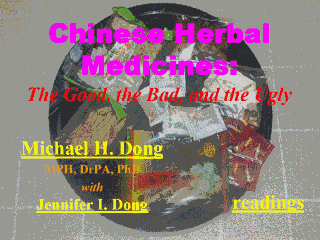| front |1 |2 |3 |4 |5 |6 |7
|8 |9 |10 |11 |12 |13 |14 |15 |16 |17 |18 |19 |20 |21 |22 |23 |review |
 |
Traditional
Chinese medicine (TCM), which comprises principally Chinese herbal medicine (CHM) and
acupuncture, has been practiced in China for at least 4,000 years. The papers and books
written on these subjects in English collectively are in the hundreds, if not thousands. The intent of this lecture is not to take any of their places. Rather, it is simply an attempt to offer a quick overview of the subject matter in the most efficient way; that is, via a series of slides and notes made available in the cyberspace, where information can be accessed almost at the speed of sound. It is important to note that here the lecturer is not an expert in TCM or Chinese herbology, despite the fact that he is both a board-certified nutrition specialist and a board-certified toxicologist. This lecture hence does not teach the students specifically what some of the popular or unique Chinese herbs are, or what their specific pharmaceutical uses are, other than to mention a few for illustration purposes. It also does not provide any formula for preparing them as a remedy. This lecture is designed primarily for those students who do not have any understanding of Chinese herbalism. For those students who are intrigued by the basics presented in this lecture and would like to pursue the subject matter further, they are encouraged to utilize the references and resources provided here as a starting point. |